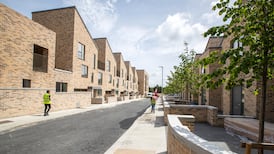The family of a child buried at Deansgrange Cemetery in Dublin are to campaign against a proposal to run enhanced cycling infrastructure through the graveyard.
Susan McGarvey, whose 12-year-old son Callum died in 2017 following an asthma attack, selected a quiet plot at the cemetery, obscured by a boundary wall, at a cost of €24,000.
She fears that plans to direct cyclists through the cemetery grounds as part of the Deansgrange Cycle Route, proposed under the Active School Travel programme, will upset the peaceful environment.
“I go down there and I sit there in the sun and I sit there in the rain and I sit at his grave and talk to him,” she said. “And I just feel that, you know, people walking past and cycling past, I don’t like it. I’m just really not happy about it at all.”
RM Block
Ms McGarvey is particularly concerned that a partial removal of the nearby surrounding wall, opening up views of passing traffic, would impose on the privacy of her family’s visits.
Plans for the route, part of a broader 25km network of dedicated cycle tracks joining 65 schools, are due to open to six weeks of public consultation from Thursday.
‘Host of sensitivities’
A previous version, which would have created a one-way traffic system on part of the Deansgrange Road, proved too controversial and forced a compromise, redirecting 200m of the 900m route through the cemetery.
The council’s director of services, Robert Burns, last year acknowledged a “host of sensitivities around Deansgrange Cemetery”, but said the route would be implemented in a “sensitive, tasteful and respectful manner”.
Those assurances may not be enough to ease anxieties around what some believe to be an inappropriate use of cemetery land, even though walking and cycling is already common there.
The council believes that adding public lighting in the cemetery and lowering the surrounding wall to allow visibility of the roadway are essential for public safety.
Where Ms McGarvey fears the infrastructure will alter the setting of her son’s grave, she is unlikely to be alone. People Before Profit councillor Melisa Halpin said she had been contacted by a constituent with similar concerns, who had buried his wife in the cemetery.
Public consultation
“I kind of understand that opinions are going to be mixed on this,” she said. “I am really glad that this is going out to proper public consultation and people can make their voices heard.”
Fine Gael TD for Dún Laoghaire Jennifer Carroll MacNeill, who has spoken with Ms McGarvey, said she had considerable sympathy for their situation. “We need to make sure, through this public consultation, that we can assess the design and make whatever changes may be needed to ensure their privacy and dignity,” she said.
Locally, the consultation process is expected to expose divisions, and many point out that the graveyard is already actively used by walkers and cyclists, particularly during the Covid period.
A spokeswoman for Dún Laoghaire-Rathdown County Council said it was not proposing a dedicated cycle path in the cemetery but rather “better access to the existing area where driving, cycling and walking is a well-established use”.
The council, she said, had “received comments from families who welcome a safe option to cycle in this area. We have also some messages of concern about the appropriateness of making these areas more accessible.”
When the public engagement process gets under way, focus groups are planned to engage with the public and receive feedback.















